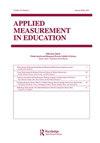Detecting Item Parameter Drift in Small Sample Rasch Equating
IF 1.1
4区 教育学
Q3 EDUCATION & EDUCATIONAL RESEARCH
引用次数: 0
Abstract
ABSTRACTScreening items for parameter drift helps protect against serious validity threats and ensure score comparability when equating forms. Although many high-stakes credentialing examinations operate with small sample sizes, few studies have investigated methods to detect drift in small sample equating. This study demonstrates that several newly researched drift detection strategies can improve equating accuracy under certain conditions with small samples where some anchor items display item parameter drift. Results showed that the recently proposed methods mINFIT and mOUTFIT as well as the more conventional Robust-z helped mitigate the adverse effects of drifting anchor items in conditions with higher drift levels or with more than 75 examinees. In contrast, the Logit Difference approach excessively removed invariant anchor items. The discussion provides recommendations on how practitioners working with small samples can use the results to make more informed decisions regarding item parameter drift. Disclosure statementNo potential conflict of interest was reported by the author(s).Supplementary materialSupplemental data for this article can be accessed online at https://doi.org/10.1080/08957347.2023.2274567Notes1 In certain testing designs, some items may be reused as non-anchor items on future forms. Although IPD can occur on those items, we use the traditional IPD definition as specific to differential functioning in the items reused to serve as the equating anchor set.2 In IRT, the old form anchor item parameter estimates can also come from a pre-calibrated bank. However, we use the old and new form terminology as the simulation design involves directly equating to a previous form.3 For example, assume an item drifted in the 1.0 magnitude condition from b = 0 to 1 between Forms 1 and 2, this item would be treated as having a true b of 1.0 if selected on the Form 3.小样本拉希方程中项目参数漂移检测
【摘要】筛选参数漂移项有助于防止严重的有效性威胁,保证等分时的分数可比性。尽管许多高风险的资格考试都是在小样本量下进行的,但很少有研究调查了检测小样本方程漂移的方法。本研究表明,在小样本条件下,一些锚项目显示项目参数漂移的情况下,几种新研究的漂移检测策略可以提高等效精度。结果表明,最近提出的方法mINFIT和mOUTFIT以及更传统的Robust-z有助于减轻漂移锚项目在较高漂移水平或超过75名考生的条件下的不利影响。相反,Logit差分方法过多地删除了不变锚项。讨论提供了关于从业者如何使用小样本来使用结果对项目参数漂移做出更明智的决策的建议。披露声明作者未报告潜在的利益冲突。补充材料本文的补充数据可在线访问https://doi.org/10.1080/08957347.2023.2274567Notes1在某些测试设计中,有些项目可能会在未来的表格中作为非锚项目重复使用。虽然IPD可能发生在这些项目上,但我们使用传统的IPD定义,将其作为重复使用的项目中的微分功能作为等价锚集在IRT中,旧形式的锚项目参数估计也可以来自预先校准的库。然而,我们使用新旧表单术语,因为模拟设计涉及直接等同于以前的表单例如,假设一个项目在表格1和表格2之间从b = 0到1的1.0量级条件下漂移,如果在表格3上被选中,则该项目将被视为具有真值为1.0的b。
本文章由计算机程序翻译,如有差异,请以英文原文为准。
求助全文
约1分钟内获得全文
求助全文
来源期刊

Applied Measurement in Education
Multiple-
CiteScore
2.50
自引率
13.30%
发文量
14
期刊介绍:
Because interaction between the domains of research and application is critical to the evaluation and improvement of new educational measurement practices, Applied Measurement in Education" prime objective is to improve communication between academicians and practitioners. To help bridge the gap between theory and practice, articles in this journal describe original research studies, innovative strategies for solving educational measurement problems, and integrative reviews of current approaches to contemporary measurement issues. Peer Review Policy: All review papers in this journal have undergone editorial screening and peer review.
 求助内容:
求助内容: 应助结果提醒方式:
应助结果提醒方式:


